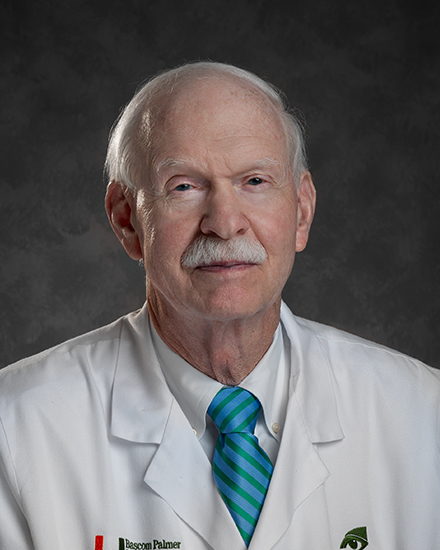Roles
Professor of Ophthalmology
J. Donald M. Gass Chair in Ophthalmology
-
Biography
My medical education and medical training began as an undergraduate at Wake Forest University where I majored in Biology and Science. After graduating in 1967, I completed my medical school at the University of Virginia, School of Medicine in 1971. It was at UVA that I became interested in Ophthalmology as a first-year medical student. I spent much of my medical school time volunteering and working in the eye clinic during those years. After internship in medicine and surgery at California Pacific Medical Center in San Francisco, I returned to the University of Virginia for a 3-year Residency in Ophthalmology. During these years of training, I developed a special interest in diseases and surgery of the Retina. I returned to San Francisco for a Retinal Fellowship finishing my training in 1976. My next move was to San Antonio, Texas for a 2-year tour of duty in the United States Army with a rank of Major. During these 2 years, I taught Residents in the Army and performed surgery on military personnel with injuries and other diseases of the retina. After an honorable discharge from the United States Army, I had the great privilege of joining the Faculty at Bascom Palmer Eye Institute as an Assistant Professor. My primary duties were to run the diabetic retinopathy studies which were just starting to recruit patients. In addition, my background in endophthalmitis allowed me to help in the care of these patients especially in terms of intravitreal antibiotics and vitrectomy. These areas of interests provided me the basis for academic contributions and to participate as a speaker at local, state, national and international meetings. During the more than 4 decades on the faculty, I have published over 700 PubMed papers, over 100 book chapters and edited 7 books. I have received multiple recognitions including honors from the American Academy of Ophthalmology, the Retina Society, the American Society of Retina Specialists, and the Florida Society of Ophthalmology. I continue to enjoy the practice of Ophthalmology and the teaching opportunities at the Bascom Palmer Eye Institute. -
Education & Training
Education
Post Graduate Training
Licensures and Certifications
-
Honors & Awards
No result found
-
Teaching Interests
Teaching has always been an important part of my role at the Bascom Palmer Eye Institute. My interest in teaching dates back to Residency at which time I enjoyed teaching the first- and second-years Residents when I was a 3rd year Resident. This special interest continued during my years of Retina fellowship and military service. At the Bascom Palmer Eye Institute, the volume of patients is much larger than in previous Eye Centers and the opportunities for clinical research is increased using outcomes studies, imaging opportunities, and new surgical techniques a reporting of new and unique information. This research is conducted and finalized in most cases by Residents and Fellows in the Department of Ophthalmology at Bascom Palmer Eye Institute. Funding for these research opportunities include, National Eye Institute, grants, private industry funding, departmental funding, and volunteer research.
Over the years of teaching, I have received numerous awards for teaching within the Department of Ophthalmology at the Bascom Palmer Eye Institute, as well as from the American Academy of Ophthalmology. These include the Charles Schepens Award from the American Academy of Ophthalmology, The Jones/Smolin Award from OMIG, the Shaler Richardson Award from the Florida Society of Ophthalmology, and many others. It is a great privilege to be able to teach Residents, Fellows, and colleagues on a daily basis. -
Research Interests
My research interests include clinical management of vision threating diseases using the newest strategies and imaging techniques. My primary interest in research has been in diabetic retinopathy which has been the leading cause of blindness in the United Stated States in individuals 65 years of age and under. Diabetic retinopathy can be advancing slowly and yet patients may not be aware of their condition. Screening of diabetic patients is very important and when disease progression is diagnosed, appropriate therapies with laser, pharmacotherapy and vitrectomy are used. Other diseases include advanced vitreoretinal diseases requiring similar strategies and treatment. These include retinal detachment, trauma, macular hole and macular epiretinal membrane and hereditary dystrophies. The final area of special interest is endophthalmitis. Endophthalmitis is defined as inflammation and/or an infection involving the fluids and tissues inside and around the eye. This condition often leads to total loss of vision. Early and aggressive treatment with intravitreal antibiotics and steroids are often utilized. In addition, pars plana vitrectomy allows removal of infectious fluids and tissues inside the eye while allowing better distribution of antibiotics injected into the eye for treatment. In this area of endophthalmitis, both inflammatory and infectious, I have published over 250 manuscripts in PubMed journals on the topic of endophthalmitis. This experience has provided me an opportunity to present our work from Bascom Palmer Eye Institute at meetings nationally and internationally over the past 4 decades.
Regarding the area of Basic Science Research, I often work with the ocular microbiology lab in conducting new research on antibiotics by using the existing cultures on culture media to allow testing of newer and potentially better ways of treating endophthalmitis and ocular infection. -
Publications
Disclaimer: The information presented in this section has been consolidated using AI and machine learning technologies. While every effort has been made to ensure accuracy, errors may occur. If you identify any inaccuracies, please use this link to inform our data team. Your feedback is greatly appreciated and helps us improve the quality of our content.


